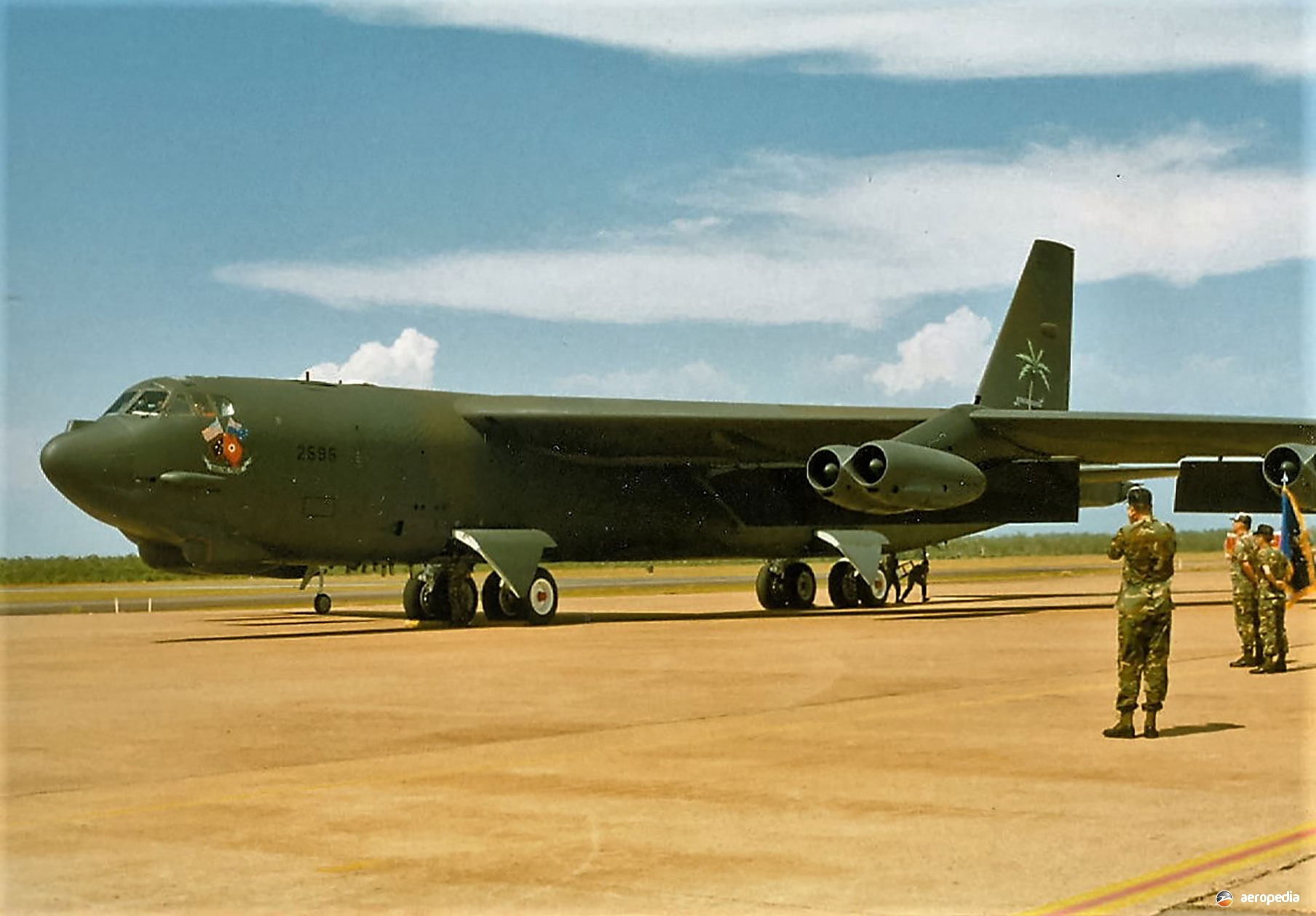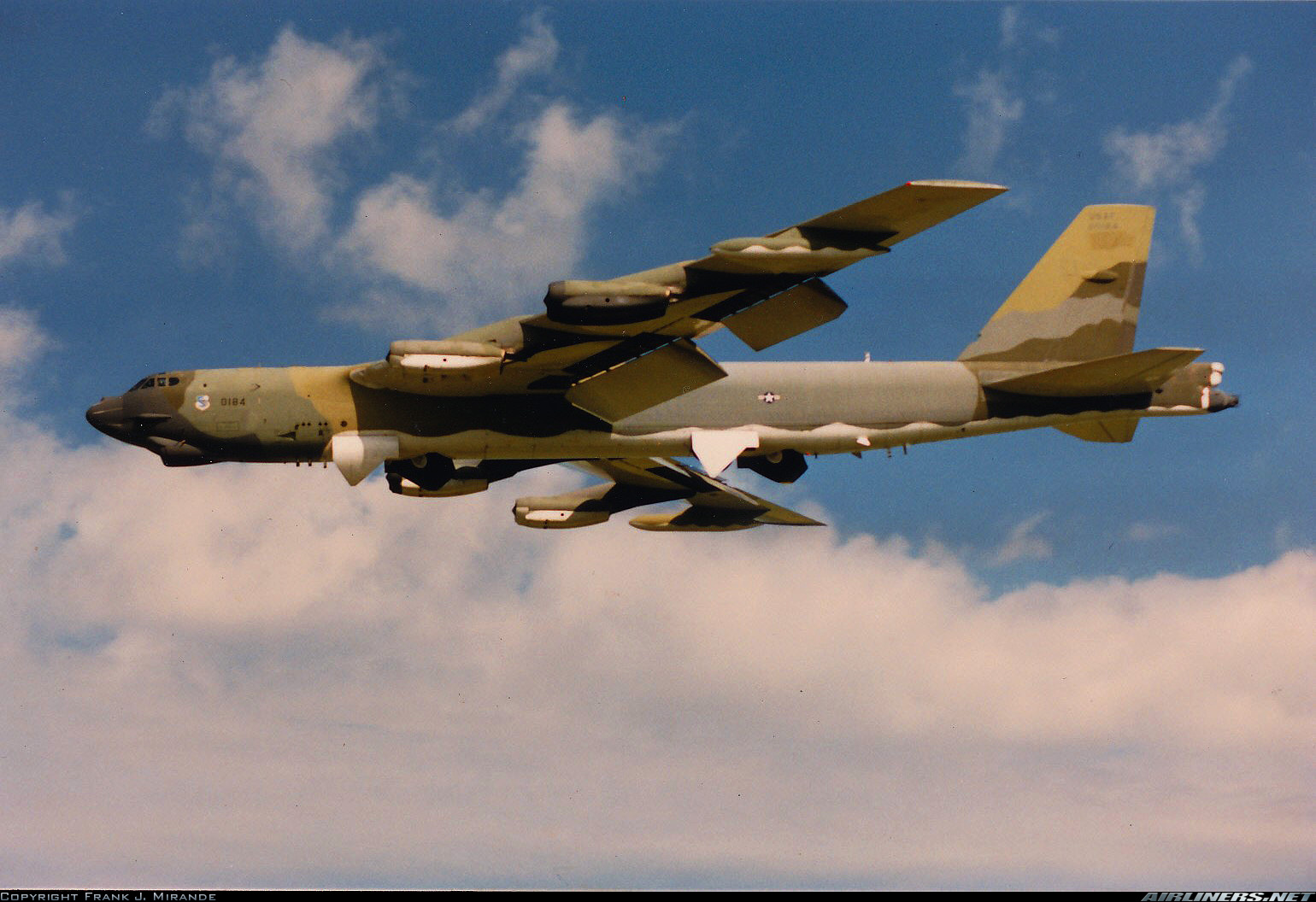
Boeing B52G Stratofortress USA Air Force Aviation Photo 2656131
The Boeing B-52 Stratofortress is an American long-range, subsonic, jet-powered strategic bomber. The B-52 was designed and built by Boeing, which has continued to provide support and upgrades. It has been operated by the United States Air Force (USAF) since the 1950s.

Boeing B52G Stratofortress USA Air Force Aviation Photo 1169702
Specs The Boeing B-52 was developed as a strategic long-range bomber. Originally designed to deliver nuclear weapons from high altitude, it has demonstrated flexibility in a variety of unforeseen roles. During the Vietnam War, the aircraft was adapted to carry up to 84 500-pound conventional bombs.

Boeing B52G Stratofortress USA Air Force Aviation Photo 0057006
B-52G Stratofortress. Photograph Courtesy of the US Air Force By Kennedy Hickman Updated on October 03, 2019 On November 23, 1945, only weeks after the end of World War II, the US Air Material Command issued performance specifications for a new long-range, nuclear bomber.

Boeing B52G Stratofortress USA Air Force Aviation Photo 0318190
Specifications: Wingspan: 56.38 m (185 ft) Length: 48.06 m (157 ft 7 in) Height: 12.43 m (40 ft 8 in) Wing area: 371.6 m² (4,000 sq ft) Max speed: 1,014 km/h (630 mph) Cruising speed: 909 km/h (565 mph) Service ceiling: 18,288 m (60,000 ft) Range: 20,116 km (12,500 miles) Empty weight: 100,407 kg (221,357 lb) Loaded weight: 221,116 kg (488,000 lb)

Boeing B52G Stratofortress USA Air Force Aviation Photo 0702918
The B-52 Stratofortress is a long-range, heavy bomber that can perform a variety of missions. The bomber is capable of flying at high subsonic speeds at altitudes up to 50,000 feet. Pictured: A B-52 Stratofortress assigned to the 2nd Bomb Wing at Barksdale Air Force Base, Louisiana, flies over Andersen Air Force Base, Guam, in support of a Bomber Task Force deployment, October 20, 2023.

BOEING B52 STRATOFORTRESS · The Encyclopedia of Aircraft David C.
First flown on April 15, 1952, the prototype YB-52 Stratofortress was America's first all jet-engine intercontinental strategic bomber. The B-52D was the most numerous version in service when Stratofortress planes were ordered to support the Vietnam War in 1965.

Boeing B52G Stratofortress USA Air Force Aviation Photo 1508614
The Last Flight of Hobo 28. On January 21, 1968, the crew of a Boeing B-52G like this ejected over Greenland after a fire broke out in their bomber. (© Boeing) In one of America's worst "Broken Arrow" incidents, a B-52 carrying four hydrogen bombs crashed on the ice off Greenland. Major Alfred D'Amario thought the worst was over after.

Boeing B52G Stratofortress USA Air Force Aviation Photo 0315423
Boeing B-52 Stratofortress, a U.S. high-altitude bomber, dropping a stream of bombs over Vietnam. The B-52 has a wingspan of 185 feet (56 metres) and a length of 160 feet 10.9 inches (49 metres). It is powered by eight jet engines mounted under the wings in four twin pods.

Boeing B52G Stratofortress USA Air Force Aviation Photo 0246809
The Boeing B-52 Stratofortress, in service today, almost seventy years after its first test flight, is one of the most versatile and successful aircraft ever designed.

Boeing B52G Stratofortress USA Air Force Aviation Photo 0027729
One of the most recognizable aircraft in the world and an icon of the United States' Cold War deterrent, the B-52 Stratofortress was for decades the U.S. Air Force's primary strategic nuclear.

Boeing B52G Stratofortress USA Air Force Aviation Photo 0484774
The B-52G introduced a shorter vertical tail and numerous internal changes, including a new integral-tank wing with internal fuel capacity increased to 46,576 U.S. gallons and with external drop tanks reduced in volume to 700 U.S. gallons each.. A B-52 Stratofortress from the 2nd Bomb Wing, Barksdale Air Force Base, La., receives fuel from a.

Boeing B52G Stratofortress USA Air Force Aviation Photo 2787745
The People Behind the B-52. We bring together all those who have been or are associated with the BUF—designers and builders, aircrew, maintainers, enthusiasts — to exchange memories. We try to help old buddies find each other -- anything it takes to keep alive the history of the weapon known in its early days as "America's Long Rifle.".
.jpg)
Boeing B52 Stratofortress Wikiwand
The B-52 Stratofortress is a large, long-range heavy bomber that was first introduced in 1955. It is a four-engine, long-range strategic bomber operated by the United States Air Force and its primary missions are conventional bombing, and conventional and nuclear missions.

Boeing B52G Stratofortress USA Air Force Aviation Photo 0827969
The B-52H Stratofortress is a long-range, heavy bomber that can perform a variety of missions. The bomber is capable of flying at high subsonic speeds at altitudes of up to 50,000 feet (15,166.6 meters). It can carry nuclear or precision guided conventional ordnance with worldwide precision navigation capability. Features

Boeing B52G Stratofortress USA Air Force Aviation Photo 0663482
About Specs At HAFB FAQs Shop History of the B-52G Stratofortress The B-52 is a long-range, heavy bomber. Unlike previous bombers, B-52s carry air-launched cruise missiles (ALCM), which reduce the risk of enemy fire by allowing B-52s to launch bombs farther from their targets.

B52G Stratofortress
The Boeing B-52 Stratofortress was developed and manufactured by Boeing as a long-range, subsonic, strategic bomber that can carry a maximum of 32,000 kg of weapons with a particular combat range of above 7,600 nautical miles without aerial refueling. Since 1950, the jet-powered bomber has served the United States Air Force. The B-52 was produced from 1952 to 1962.